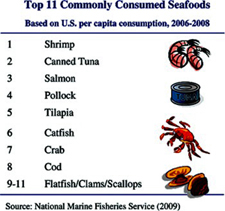

From the Global Seafood Cookbook:
Seafood is an excellent source of essential minerals
(iron, phosphorus, potassium and zinc), protein and vitamins (B, B-6, B-12, biotin and
niacin). Canned fish (salmon or sardines) are also rich in calcium. In
addition, many species of seafood are low in calories, cholesterol and
sodium. Seafood contains roughly twenty percent of the same proteins
found in poultry and red meat. There are certain varieties of fish that
are high in fat such as catfish, mackerel and salmon (also a good source
of Vitamin A), but their fat content is chiefly unsaturated. Oily fish
(herring, mackerel, salmon, sardines and tuna) are also rich in Omega-3
acids.
The
USDA (United States
Department of Agriculture) Dietary Guidelines for Americans recommends people eat two
servings (8 ounces) of seafood on a weekly basis. The
USDA Choose My Plate site also reports
that common portions and ounce equivalents for one ounce of cooked fish
or shellfish is one can of tuna, drained (=3 to 4 ounce equivalents),
one salmon steak (=4 to 6 ounce equivalents) and one small trout (=3
ounce equivalents).
From the USDA:
Why is it important to eat 8 ounces of seafood per week? Seafood contains a range of nutrients, notably the Omega-3 fatty acids, EPA and DHA. Eating about 8 ounces per week of a variety of seafood contributes to the prevention of heart disease. Smaller amounts of seafood are recommended for young children. Seafood varieties that are commonly consumed in the United States that are higher in EPA and DHA and lower in mercury include salmon, anchovies, herring, sardines, Pacific oysters, trout, and Atlantic and Pacific mackerel (not king mackerel, which is high in mercury). The health benefits from consuming seafood outweigh the health risk associated with mercury, a heavy metal found in seafood in varying levels.
 Other benefits of a seafood-rich diet
include:
Other benefits of a seafood-rich diet
include:
•Can lower blood pressure.
•Can lower blood triglycerides (fats).
•Can improve symptoms of inflammatory diseases such as arthritis and psoriasis.
•Can reduce the risk of heart disease.
•May improve heart function and reduce damage from heart disease.
•May prolong life after a heart attack.
Data Source: Fish-Ex.
According to the American Journal of Preventive Medicine via the Seafood Nutrition Partnership, a new study undertaken by UCLA resident radiologist Dr. Cyrus Raji found that eating fish (baked or broiled, but never fried) is associated with larger gray matter volumes in brain areas responsible for memory and cognition in healthy elderly people.
![]() USDA Seafood Nutrition Facts
USDA Seafood Nutrition Facts
Based on a 3 oz./84g cooked edible serving with no added ingredients.
|
Fish Species |
Calories |
Protein |
Cholesterol |
Total Fat |
Sodium |
|
Catfish |
130 |
17g |
50mg |
6g |
40mg |
|
Crab |
100 |
20g |
95mg |
1g |
330mg |
|
Clams (12
small) |
110 |
17g |
80mg |
1.5g |
95mg |
|
Cod |
90 |
20g |
50mg |
1g |
65mg |
|
Crayfish |
70 |
15g |
115mg |
1g |
80mg |
|
Flounder/Sole |
100 |
19g |
55mg |
1.5g |
100mg |
|
Grouper |
100 |
21g |
40mg |
1g |
45mg |
|
Haddock |
100 |
21g |
70mg |
1g |
85mg |
|
Halibut
|
120 |
23g |
40mg |
2g |
60mg |
|
Herring |
210 |
18g |
85mg |
15g |
80mg |
|
Lobster |
80 |
17g |
60mg |
0.5g |
320mg |
|
Mackerel |
170 |
20g |
50mg |
9g |
95mg |
|
Mahi-Mahi |
90 |
20g |
80mg |
1g |
95mg |
|
Monkfish |
80 |
16g |
30mg |
2g |
20mg |
|
Mussels |
150 |
20g |
50mg |
4g |
310mg |
|
Ocean Perch |
110 |
21g |
45mg |
2g |
95mg |
|
Octopus |
140 |
25g |
80mg |
2g |
390mg |
|
Orange Roughy |
80 |
16g |
20mg |
1g |
70mg |
|
Oysters (12
medium) |
100 |
10g |
80mg |
4g |
300mg |
|
Pollock |
90 |
20g |
80mg |
1g |
110mg |
|
Rainbow Trout |
140 |
20g |
55mg |
6g |
35mg |
|
Redfish |
110 |
21g |
50mg |
2g |
95mg |
|
Rockfish |
110 |
21g |
40mg |
2g |
70mg |
|
Salmon (Atlantic,
Chinook, Coho & Sockeye) |
200 |
24g |
70mg |
10g |
55mg |
|
Salmon (Chum
& Pink) |
130 |
22g |
70mg |
4g |
65mg |
|
Scallops (6
lg. or 14 sm.) |
140 |
27g |
65mg |
1g |
310mg |
|
Sea Bass |
110 |
20g |
45mg |
2g |
75mg |
|
Shrimp |
100 |
21g |
170mg |
1.5g |
240mg |
|
Snapper |
100 |
21g |
40mg |
2g |
70mg |
|
Squid |
150 |
15g |
220mg |
6g |
260mg |
|
Swordfish |
120 |
16g |
40mg |
6g |
100mg |
|
Tilapia |
110 |
22g |
75mg |
2.5g |
30mg |
|
Tuna |
130 |
26g |
50mg |
1.5g |
40mg |
|
Turbot |
100 |
17g |
50mg |
3g |
160mg |
|
Whitefish |
150 |
21g |
65mg |
6g |
55mg |
|
Whiting |
100 |
20g |
70mg |
2g |
110mg |
Data Source: USDA (United States Department of Agriculture).
![]()
HOME | Recipes | News & Updates | About Food Fare | Contact | Site Map